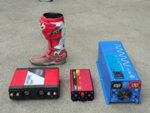- Likes
- 4,052
- Location
- Lake Havasu City, AZ
I have had a 12-110V inverter in my van for a couple of years. It is a Traveller 3,000W Digital Power Inverter, sold at Tractor Supply for under $300.

Initially I bought it to use an electric pressure washer at the track (still need to think up a water tank for it!). It is not a pure but a modified sine wave inverter. It won't run my Nespresso machine.

It can charge a Redshift, but it takes a long time, possibly even longer than a 110V household power. I have been charging my MX with it between motos, but was only able to extend my practice day by maybe ~10 minutes. I also used it a few times while driving the van to/from the track.
The LED display shows only 550W when it runs, but the Kill-A-Watt Meter shows a more expected 1250W. I do not know who to believe. The van's engine has to be running, else the battery voltage drops too low in just 2-3 minutes.
Then, after buying a Redshift, I found a bunch of 12-220V inverters on a Chinese website with a reputable sounding name Banggood.com. This is a UKC® 12V To 220V 4000W Modified Sine Wave Inverter. For just $89 delivered from China to my door it was worth a try.

It draws too much current and shuts itself off in under a minute. I can get just a few seconds of "rapid" 220V charging out of it, LOL!
It might work if I get a (much) bigger van's alternator. Stock alternators for my van are rated at only 180 - 220 Amps. Or I could add several 12V batteries and keep them charged. Build my own Tesla Powerwall.
Does anyone have any practical experience with such inverter setups?

Initially I bought it to use an electric pressure washer at the track (still need to think up a water tank for it!). It is not a pure but a modified sine wave inverter. It won't run my Nespresso machine.
It can charge a Redshift, but it takes a long time, possibly even longer than a 110V household power. I have been charging my MX with it between motos, but was only able to extend my practice day by maybe ~10 minutes. I also used it a few times while driving the van to/from the track.
The LED display shows only 550W when it runs, but the Kill-A-Watt Meter shows a more expected 1250W. I do not know who to believe. The van's engine has to be running, else the battery voltage drops too low in just 2-3 minutes.
Then, after buying a Redshift, I found a bunch of 12-220V inverters on a Chinese website with a reputable sounding name Banggood.com. This is a UKC® 12V To 220V 4000W Modified Sine Wave Inverter. For just $89 delivered from China to my door it was worth a try.

It draws too much current and shuts itself off in under a minute. I can get just a few seconds of "rapid" 220V charging out of it, LOL!
It might work if I get a (much) bigger van's alternator. Stock alternators for my van are rated at only 180 - 220 Amps. Or I could add several 12V batteries and keep them charged. Build my own Tesla Powerwall.
Does anyone have any practical experience with such inverter setups?



